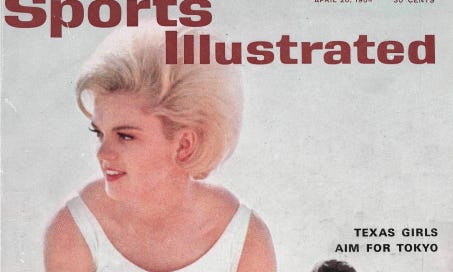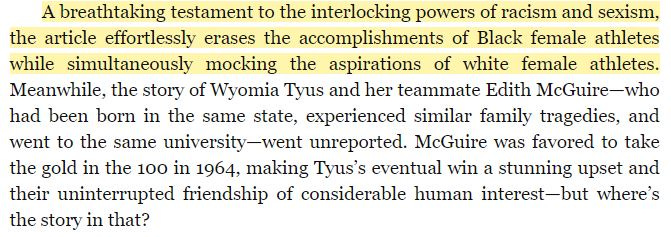The Flamin' Mamie's Bouffant Belles
Plus: Remember to register for the Wyomia Tyus event on March 8!
Hi, friends! Welcome to Power Plays, a no-bullshit newsletter about sexism in sports, written by me, Lindsay Gibbs.
Happy Friday!
Before we head into the archives today, here are two important reminders about virtual Power Plays events this upcoming week:
THIS MONDAY, March 8, at 7:00 p.m. ET, the legendary Wyomia Tyus will join Power Plays subscribers for a Q&A
This incredible event is available ONLY to Power Plays paid subscribers, and you can register for the event here.
We will be talking about her memoir, Tigerbelle: The Wyomia Tyus Story. Her co-author, Elizabeth Terzakis, will be there as well. Please make it if you can! Even if you haven’t had time to finish the book, come! This is a big deal for our little newsletter, and if there’s a good turn-out and lively conversation, it will make it much easier for me to schedule more Olympic champions in our future!
If you have questions for Tyus and Terzakis for the Q&A, please go ahead and email them to me at lindsay@powerplays.news, with “Wyomia Tyus Q&A” in the subject line!
I’m so excited about this. Please come.
Then, on Saturday, March 13, at 8:00 p.m. ET, we are having our very first Power Plays Virtual Party
Since we’re still not super close to in-person gatherings, the wonderful Eleana Gudema has planned a party just for Power Plays subscribers!
She tells me there will be trivia and a treasure hunt, and also just time to chat about our lives and about women’s sports. BYOBeverage.
You can register for the party here.
From the archives: Track’s cover girls
When reading a Power Plays Book Club book, I’m always looking for tangents to explore. And one popped up very early in “Tigerbelle,” in Terzakis’s intro when she was listing the many reasons why Wyomia Tyus’s story isn’t as well known as it should be.
She mentioned that in 1964, the year that Tyus would go on to win Olympic gold in the 100m, Sports Illustrated put women’s track on its cover for the first time. But, as you can probably guess, the cover had nothing to do with Tyus. Rather, it was white girls from Texas with big hair.
This is the type of thing that sounds too on-the-nose to be true, so I immediately went and purchased a subscription to the Sports Illustrated archives to check things out.
And friends? The entire thing is even more ridiculous than I imagined.
Yes, that was the cover. A real cover from April 20, 1964.
The feature article inside was, somehow, entitled, “Flamin’ Mamie’s Bouffant Belles: A beauty-minded Texan pioneers a new glamorous look in women’s track.”
In case you don’t believe me:
Here are some excerpts from that article, as well as a link so you can check the entire thing out.
I guess we’ll start at the beginning?
Early one morning last month, when nothing was stirring in Abilene, Texas but the reels of Muzak tape in a storefront on North Fourth Street, Mrs. Margaret Ellison put her gold starting blocks and red-white-and-blue batons in the trunk of her car and set out for Austin. A can of Rayette's The Young Set hair spray rolled about on the floor, a javelin rattled against the top of the dash, and blaring forth from the radio were, or so said one of the three girls in back, "the Imitation Beatles." She added disarmingly, "Did you know England just declared war on the United States? Lady Bird ate a Beatle."
Mrs. Ellison, who is known by her passengers (to her face) as Miz El'son or (behind her back) as Flamin' Mamie or Ma Kettle, is a 46-year-old divorcée who wears her tinted strawberry-blonde hair in what she calls a "chignon rat."
The article notes that from 9-5, Ellison is a secretary, but after hours she is the coach of the all-girls Texas Track Club.
I’ll let Gilbert Rogin take it from here:
The Texas Track Club is celebrated on two counts—its athletic achievements and the uncommon beauty of its girls, who compete in dazzling uniforms, elaborate makeup and majestic hairdos. These hairdos, which are either bouffant or flip if at all possible, may not be aerodynamically sound and may be "out" east of the Hudson, but they are an unqualified sensation at a track meet. "They are our trademark," says Jeanne Ellison, the coach's 16-year-old daughter. "Bouffant is easier to run in because the wind doesn't blow your hair in your face."
In one sense, the Texas Track Club has done more to promote women's track in the U.S. than if its members had, say, won the national AAU championships. (In fact, they finished 12th last year, with a third in the 440-yard relay and the 220-yard low hurdles and a sixth in the 220-yard dash.) After the age of 10, American girls generally lose interest in running—it is unbecoming and too far out. And American boys generally lose interest in the few girls who take up the sport, the popular belief being that they look like Olive Oyl or Tugboat Annie. The Texas Track Club, however, has shown that you can be beautiful and still run the 100 in 10.9. Because of this delightful anomaly, its members have been a hit—and spread the gospel—at such topflight meets as the Los Angeles, Albuquerque and Dallas Invitationals. And it is not at all unlikely that a couple of Mrs. Ellison's girls will make the U.S. Olympic team.
"I'm trying to change the stereotyped image of the track girl," says Mrs. Ellison. "Every year we have a good-looking team and good-looking uniforms—none of those bags. I prefer pretty girls. I insist that they wear makeup. We all go to the beauty shop before each meet, so we can get beautiful and get our minds off the meet. When we ran in Albuquerque this January, I could have killed myself. They have the worst beauty operators in the world in Albuquerque. After I came out of one shop, I went right into another one where this man made my hair worse. I had to go back to the motel and do it myself. We have different hairdos for each meet. We straighten a lot of girls' hair, but of course you can't make it too bouffant when it's natural-curly."
What Wyomia thought of Flamin’ Mamie
Runner’s World did a great piece in 2015 looking back at this infamous cover. The writer of the feature, Gil Rogan, told RW, “It was all just a stunt. It wasn’t a track story.”
But I do believe that sells the story a bit short.
After all, Margaret Ellison wasn’t completely a fringe figure in the world of track. While her athletes didn’t win Olympic medals, they regularly qualified for national meets, and she had one athlete qualify for the 1980 Olympics, which of course Team USA boycotted.
In 1963, Ellison became the first woman to serve as the coach for the national women’s track team when the United States traveled to Russia, Poland, German, and England for a six-week competition tour in the summer.
Tyus was just out of high school at the time and on her way to Tennessee State where she’d become a Tigerbelle, and she was one of the stars on that ‘63 team. In her book, Tyus is open that she was not impressed with Ellison.
Of course, her frustration was warranted! While I couldn’t find the exact Sports Illustrated photo and caption that Tyus writes about, it’s clear that the press had a huge appetite for white style over Black substance in its women’s sports coverage, and that Ellison had no problem feeding into that.
The legacy of the Belles
Terzakis summed this all up the best when she referred to the Sports Illustrated debacle as, “a breathtaking testament to the interlocking powers of racism and sexism.”
On one hand, well before Title IX, Ellison started a track team for her daughters because she did not feel like the co-ed track team at the elementary school was giving the girls any guidance. She scouted girls and recruited them and coached them and found ways to fund their travel to meets all over the continent. And, as absolutely absurd as her focus on looks was, it was also a brilliant marketing gimmick that helped drum up interest and support. Ellison coached for about three decades, and in 1965, was named Women’s Track Coach of the Year.
Some might say that the entire thing was even a bit subversive?
“Clusters of male spectators materialized out of nowhere. Binoculars were visible peering out of windows from the men's dormitory across the street.” Jeanne Ellison Biggs, Ellison’s daughter, told Runner’s World.
“Because we were all ‘frou-frou'ed’ up, and looked real nice when we would walk out there on the track, all the girls on the other teams would look at us and laugh,” she says. “They were like, ‘They look good but they can’t run.’ Then we would perform well and show them up.”
Ultimately, though, the whole thing is just infuriating. It’s infuriating that that’s what it took to get women on the Sports Illustrated cover. (Remind anyone a bit of Kournikova, 35 years later?) It’s infuriating that Ellison so exploited the racism and sexism of her time, and that the media just ate it up. And it’s especially infuriating that Ed Temple and the Tigerbelles never got their Sports Illustrated cover.
Thanks for reading Power Plays! See you all next week.











